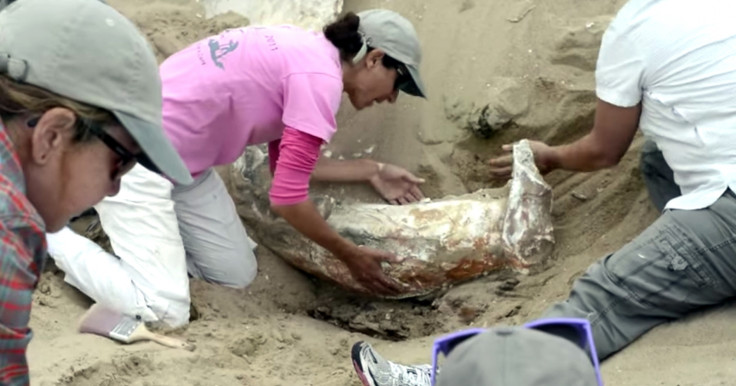Californian Archaeologists Excavate Long-Lost Egyptian Ten Commandments Movie Set From 1923

Archaeologists are excavating giant sphinxes in Guadalupe-Nipomo Dunes, Santa Barbara, in the middle of the Californian desert, which are part of the remains of an incredibly elaborate Egyptian film set from 1923.
Over 30 years before the release of the famous Oscar-winning epic The Ten Commandments in 1956, director Cecil B DeMille shot a black-and-white silent film of the same title that featured a prologue telling the story of the Exodus, with the rest of the movie concerning two brothers in modern times and their views on the Ten Commandments.
Using the Californian rolling dunes to replicate the Egyptian desert, the period part of the film featured complete, staggeringly-detailed ancient Egyptian monuments known as "Pharaoh's City".
Built by 1,600 set designers, carpenters and craftsmen, the set included 35ft-tall Pharaoh statues and 21 large sphinxes lining a boulevard up to the entrance of a huge 700ft-tall Egyptian temple facade.
DeMille was quite an eccentric man and after the film was completed, he ordered the Pharaoh's City to be blown up using dynamite, the remains buried in the dunes and the location to remain a closely-guarded secret.
Finding the lost Pharaoh's City

Eventually in 1983, huge fans of DeMille's work used cryptic clues left in his autobiography, which was published posthumously in 1959 to figure out where the 1923 film set was located, and gradually over time, relentless north-westerly gales had managed to blow away most of the sand covering the remains of the set.

DeMille wrote in his autobiography: "If 1,000 years from now, archaeologists happen to dig beneath the sands of Guadalupe, I hope they will not rush into print with the amazing news that Egyptian civilisation, far from being confined to the valley of the Nile, extended all the way to the Pacific coast of North America."
In 1999, a non-profit educational and preservation centre was set up by concerned Californian citizens called the Guadalupe-Nipomo Dunes Center with the mission of preserving the coastal dune ecosystem.
Since 2012, archaeologists have been excavating the area to try to recover artefacts from the set for the Dunes Center as a crucial part of modern American history, particularly the large sphinxes, which each weighed 5 tonnes.
In 2012 they managed to rescue and preserve the head of a giant sphinx, and now they are trying to salvage the rest of the body, which is in many pieces and has started to crumble, as well as a much smaller sphinx that is almost completely intact.
The plaster used to make the set was preserved by the sand, but now that it is gone, the remaining pieces of the set are starting to crumble away.
"Last week in a pre-project survey, we found the wind had blown the sand off, and it pretty much imploded," Dunes Center executive director Doug Jenzen told local newspaper Lompoc Record.
"But the wind also uncovered another piece 20 feet away that turned out to be another sphinx, and it's in much better shape.
"There are pictures of the actors as slaves hauling one around. We think that may be what this one is."
Running out of money to excavate
The expedition to excavate and preserve the sphinxes has cost $120,000 (£74,890), funded by California's Coastal Resource Enhancement Fund and donations from local businesses, but now without more funding and a lack of space in the Dunes Center for more artefacts, the archaeologists won't be able to continue.
But Jenzen says that although the film set isn't ancient Egyptian, it is still of significant cultural value.
"First and foremost, it's unlike anything else on Earth, and it's part of the unique character of the Central Coast," he said.
"It provides a way to preserve an important piece of Americana. It preserves the local heritage, and it promotes the local economy through heritage tourism.
"Everything we learn here will contribute to the larger archaeological field, and we're also training the future workforce through interns. Altogether, it demonstrates why it's important to be out here doing this work."
© Copyright IBTimes 2025. All rights reserved.




















